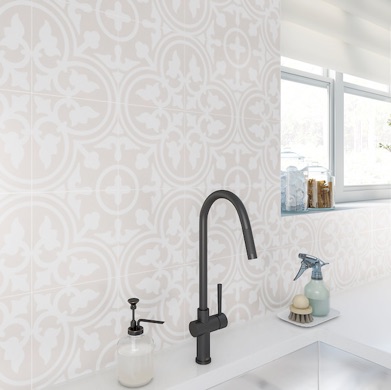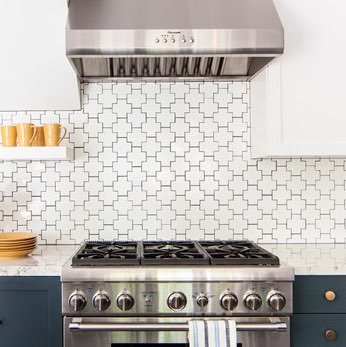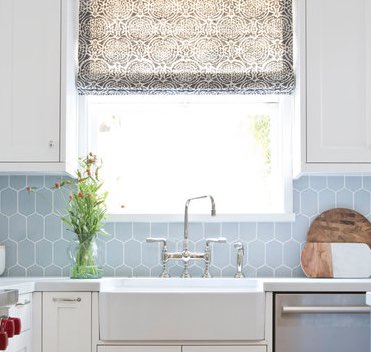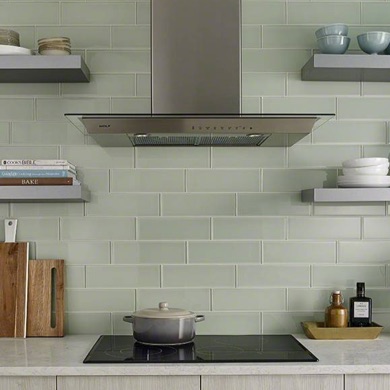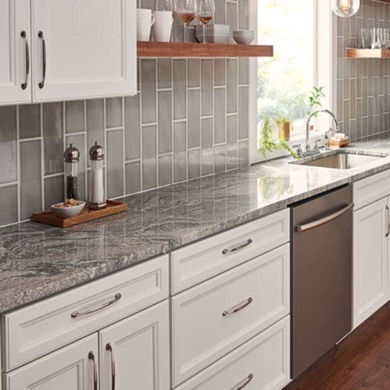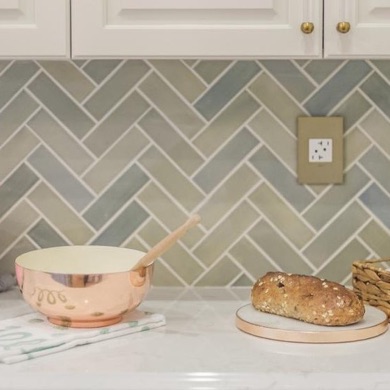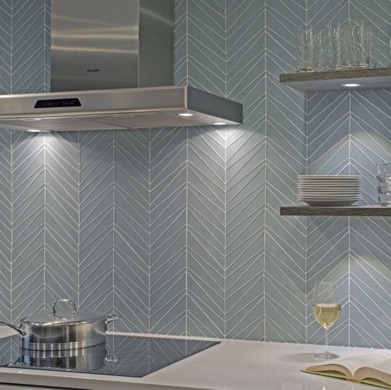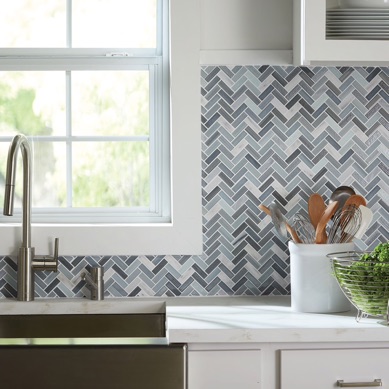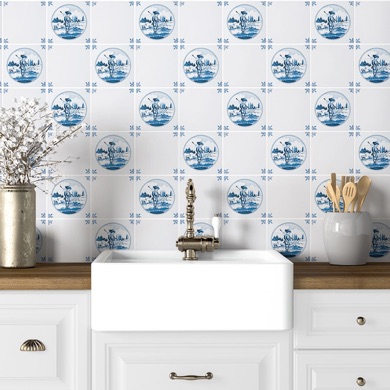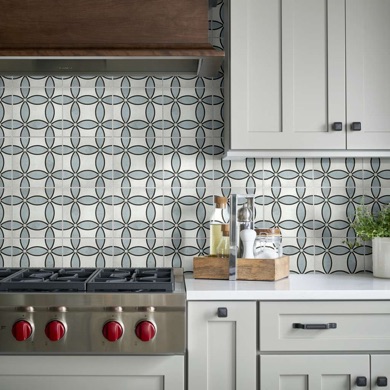the big little kitchen | Think Small, Live Large
Miles of Tiles
Near-Endless Choices Make it Easier Than Ever
To Find the Perfect Backsplash
Timeless Tile
Tile is the material of choice for most people designing a backsplash, accounting for roughly 90% of all such installations. This is largely because tile is by far the most versatile candidate for the job of covering that empty wall space behind your kitchen counter, with thousands upon thousands of possible styles, materials, sizes, colors, patterns and textures, all of which can be arranged and rearranged to create even more possibilities. Tile also adds a sense of agelessness and craftsmanship to any kitchen. After all, the stuff has been around for thousands of years. Unlike solid backsplashes made of large, monochromatic (and often monotonous) slabs of stone or quartz, tile backsplashes are more lively and dynamic. Tile is also usually far less expensive to buy and to install. Slabs are costly to purchase and transport, and they need to be carefully cut to the precise shape of the backsplash area, with lots of opportunity for errors—very expensive errors. Tile, on the other hand, can be quickly trimmed with inexpensive tools to fit whatever space needs to be covered, and if a piece breaks during installation it can quickly be replaced for a few dollars.

Fittings:
Tile Styles
Since the possibilities for creating a backsplash with tile are so vast, the first task is to narrow down the options you want to consider. This needs to be done hand-in-hand with your choices for countertops, cabinets, wall paint and even flooring. All of these elements need to work together. To make that happen you should create a design storyboard by laying out samples of each probable choice for each surface side by side, and switch them around until you have a combination that works well together. Once you have produced a short list of your three or four favorite tile colors, patterns and shapes, you can move on to selecting things like size, materials, finishes and layouts. Many styles of tile can be configured in multiple ways to create a variety of designs. This is the time to start playing with all of these variables, but remember that the point is to come to a final decision about which tiles you want to put on your wall, so the term “playing” should not be taken too literally. Many websites also have very helpful visualizing tools that let you envision what the tile you are considering will actually look like on your wall. A good one can be found at backsplash.com/designer. Another is at msisurfaces.com/virtual-kitchen-designer. In each case you are limited to the tiles the vendor offers in its inventory, but these can be a useful way to sort through general possibilities.
Even white tiles can be jazzy when they come in a distinctive shape, like these 4-inch Swiss Cross earthenware tiles from Ann Sacks, and are outlined with contrasting gray grout lines.
Oversized, 10” X 10” printed porcelain floor tiles like these Loire tiles from EliteTile can be repurposed to create a timeless, stunning and durable backsplash that may well outlast the rest of the kitchen.
The pattern on these encaustic porcelain tiles from the Annabelle series by Della Torre is created by shaping different colors of clay into the desired pattern and baking it in.
This creative combination of printed images and color-block tiles comes from ArtTiles, a small-batch workshop owned by two women/artists in Denmark, which hand prints each tile.
These navy blue Annie Selke Shadow tiles are designed to communicate the feel of hand-dyed Indonesian Batik, with soft-edge printing and a random pattern to give them an artisanal look.
Pale blue, cocoon-shaped mosaics tiles from the Sixth Avenue Collection of Walker Zanger communicate a serene simplicity that perfectly suits the design of this kitchen.
The playful pattern on these hexagonal porcelain tiles, part of the Aster series from EliteTile, can be laid out in many different ways to produce multiple eye-catching decorative schemes.
Subway Tile is Forever
The classic shape is constantly turning up in creative new configurations.
Material, Size and Finish
After you’ve settled on a general style and color for your tile, you’ll need to consider the materials used, the size of the tile you prefer, and how the colors you want are applied and finished. The most common materials used for backsplash tiles are ceramic, porcelain, glass and stone. Less common are things like terra cotta, cement and metal, which is usually used only as an accent in certain mosaic patterns. Each of these materials can be finished in a number of different ways that can greatly effect their final appearance.
-
•Ceramic tiles use traditional clay and are glazed with various colors or patterns that sit on the surface of the tile. They are inexpensive and ideal for decorative wall applications like backsplashes.
-
•Porcelain tile is made with a denser, finer grained clay and is fired at a higher temperature for a longer time, making them harder and more durable. Porcelain tiles can either be glazed, with the color on top or produced with through-body colors that are baked into the whole tile, or both.
-
•Glass tiles use colored glass that can be cut into standard rectangles or fantastically random forms to create all manner of exciting patterns on your wall. These often need to be backed with an opaque substance to obscure the adhesive or mortar used to attach them to the wall.
-
•Stone tiles are made from natural stone, usually marble or granite, that are cut into tile-sized shapes and are installed just like any other tile. Tiles made with soft stones like marble, and especially tumbled marble, need to be sealed when they are installed or they will absorb food stains and discolor.
Whatever material you select, you will need to consider the size of each tile. This is especially true when you are using a contrasting grout (that is the gypsum-based paste that is used to fill the spaces between tiles). Instead of matching the color of the tile and disappearing into the backsplash, a contrasting grout, i.e. a dark grout with a light tile, or vice-versa, will clearly define the shape of each individual tile and help to visually define the pattern in which they are laid.
While most tiles are simply finished with a single-color glaze or an applied pattern or print that is then covered with a clear glaze, encaustic tiles, which have become increasingly popular, use a centuries old technique to create integrated patterns. These tiles, usually porcelain, are made with an added layer that features two or more colors of clay that have been cut into distinct patterns, laid onto the surface of the tile and then baked into the tile, creating the appearance of being meticulously hand crafted, even though most of these are mass produced today. (See the Annabelle tiles above.)
Daltile Uptown Glass Mosaic tiles, made using 98% recycled content, mix iridescent tones and creative patterns to make a striking and distinctive design statement.
These White Gray Marble Flower mosaics from Backsplash.com are made of small pieces of white and gray marble pre-assembled into a floral pattern and sold on 12” X 12” sheets.
Mighty Mosaics
A well-designed array of these mini-tiles can make a small kitchen feel bigger.
Prints Charming
Whether your kitchen is Country, Continental or Contemporary printed patterns can add appeal.
These standard 3” X 6” Old Copper subway tiles in Seafoam Green from Mercury Mosaics are laid in a tight grid with tiles aligned vertically and horizontally, creating a quirky nod to order.
White Arabesque Mosaics from Backsplash.com offer an exotic and curvaceous alternative to the straight lines and flat-sided shapes that grace the walls of most kitchens.
These 2” X 6” Blue Opal subway tiles from Mercury Mosaics, laid out here in a herringbone pattern, are made by hand using a special glaze that creates wide color variations from tile to tile.
Long, narrow and bold, Dark Gray Slate subway tiles from Backsplash.com, laid in a traditional running-bond pattern with bright white grout, create a look that’s anything but traditional.
Ordinary 3” X 6” subway tiles glazed in a non-ordinary color, like these Dove Gray tiles from MSI Surfaces, and laid in a vertical running bond make this smart backsplash defiantly different.
Proof that glass tiles can come in all sizes and shapes these Glass Palm mosaics from Island Stone in Stratos Blue add energy and a bit of elegant edginess to this kitchen backsplash.
These blue/gray Glass & Quartz mosaics from Backsplash.com mix glass, tile, metal and quartz, all in random order and sizes to produce a high-energy and eye-pleasing pattern.
American Olean’s Serentina mosaics offer a mix of natural stone and glass in white, blue and gray, arranged in a herringbone pattern to create an artfully dynamic and playful backsplash.
Super-sized 6” X 24” Atlantic Stone tiles from Tile America laid in a subway pattern are crafted in porcelain to perfectly mimic natural stone, right down to the marble-like white veining.
Elongated 4” X 12” Arctic Ice Glass subway tiles from MSI Surfaces, arranged in a simple running bond pattern, offer a soothing, contemporary, but slightly edgy take on an age-old design.
© Copyright 2023 Terms of Use / Privacy Policy
These 8”X8” Maria printed porcelain tiles from the Revival collection by Shaw Floors, shown here in Pearl, are simple, retro and rustic, sure to evoke sweet memories of Mom and apple pie.
The pattern on these blue Zanzibar tiles from MSI Surfaces, is designed to evoke Moorish-inspired encaustic tiles of old Iberia, but these are simple printed tiles that will add spice to any backsplash.
Patchwork-printed Anya Blanco 2” X 2” porcelain tiles from MSI Surfaces are arranged in 6-tile X 6-tile grids to create a freshly up-to-date but still old fashioned and down-home appeal .
Quaintly printed 6” X 6” Country Scene glazed tiles in white and Deflt Blue from Country Floors feature a timeless pastoral scene that lends it self well to this cottage-style kitchen.
Isabella porcelain tiles in Agate, from the Revival collection of Shaw Floors, are designed to recall English Arts & Crafts patterns of the late 19th Century, but look right at home in this one.
Artfully abstract Badru patterned blue-and-white tiles from Country Floors will enliven any kitchen while reminding you that not all printed tiles are designed to remind you of times past.




